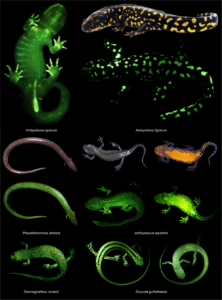by Kennedy Zittel, Naturalist
 To celebrate the week of Halloween, here is a spooky tale of things that glow in the dark… or should I say glow in the light?
To celebrate the week of Halloween, here is a spooky tale of things that glow in the dark… or should I say glow in the light?
Lurking in the depths of muddy pond water, hiding under fallen leaves, these creatures are all over our preserve! And to make it even more spooky… they glow! Any guesses?
Amphibians! No tricks here, they really do glow!
It wasn’t until recently, during studies done in 2020, that scientists realized that amphibians (including salamanders, frogs, and caecilians) have biofluorescence. Biofluorescence is when compounds found within an animal’s body absorb light and then re-emit light back at specific color wavelengths (this means when the animal is under certain light, they glow a different color!). How cool is that?
Note: Biofluorescence is different than bioluminescence. Bioluminescence is generated by a chemical or biological reaction within the animal’s body (think like a glowstick) whereas biofluorescence is when an organism emits light after having a different type of light source shone on it.
During this study, researchers shone both blue light and ultraviolet light (UV) on different species of amphibians. Then a camera that was able to pick up different green-yellow color wavelengths was used to take their picture. In the study, every species of amphibian that was photographed showcased biofluorescence!
Not every species glowed the same, the location of the glowing varied, as did the intensity of the glow. Some species, like the Eastern Tiger Salamander, had their bright yellow stripes glow bright green under blue and UV light. Other species had their entire body glow. Some species’ stripes glowed. Some just had their toes glow! Though the location and intensity of the glowing varied, all amphibian species tested glowed a greenish-yellow color. Their glow was also more intense under the blue light compared to UV light.
Because all species tested (not all species of amphibians have been tested yet) glowed (salamanders, frogs, and caecilians alike), scientists think that the biofluorescence trait appeared early in the evolutionary history of amphibians. But why?
We don’t know yet. Suggested reasons for the glowing could be to help them locate one another in the dim-lighting that amphibians are often found in, communication, camouflage, sexual selection, or even no noticeable function at all.
Now, amphibians aren’t scary and don’t make for much of a spooky Halloween story. But the fact that there is still so much to learn about these awesome creatures is so neat! Hopefully, the next time you see a frog or salamander you think about how if you were in different lighting… it would glow! Isn’t that a treat?
Image: scientific reports, “Salamanders and other amphibians are aglow with biofluorescence”
